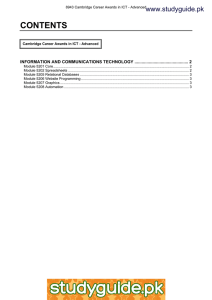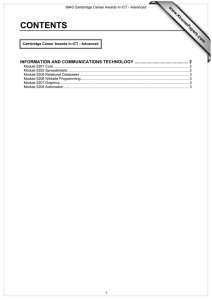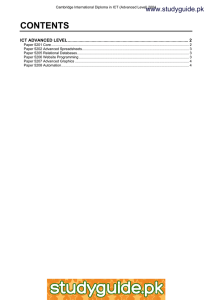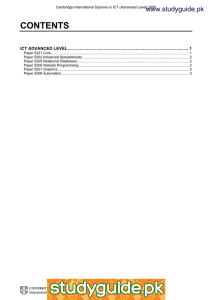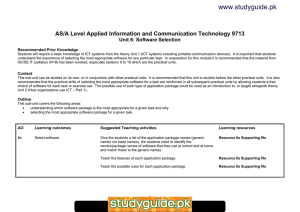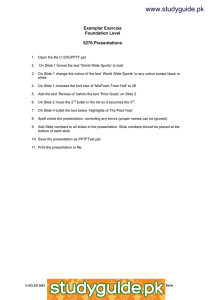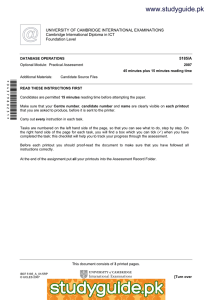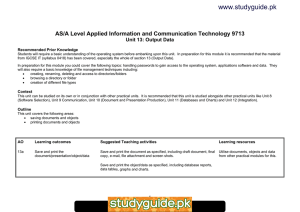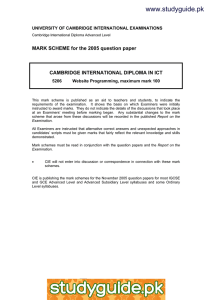CONTENTS www.studyguide.pk INFORMATION AND COMMUNICATIONS TECHNOLOGY ............................................. 2
advertisement
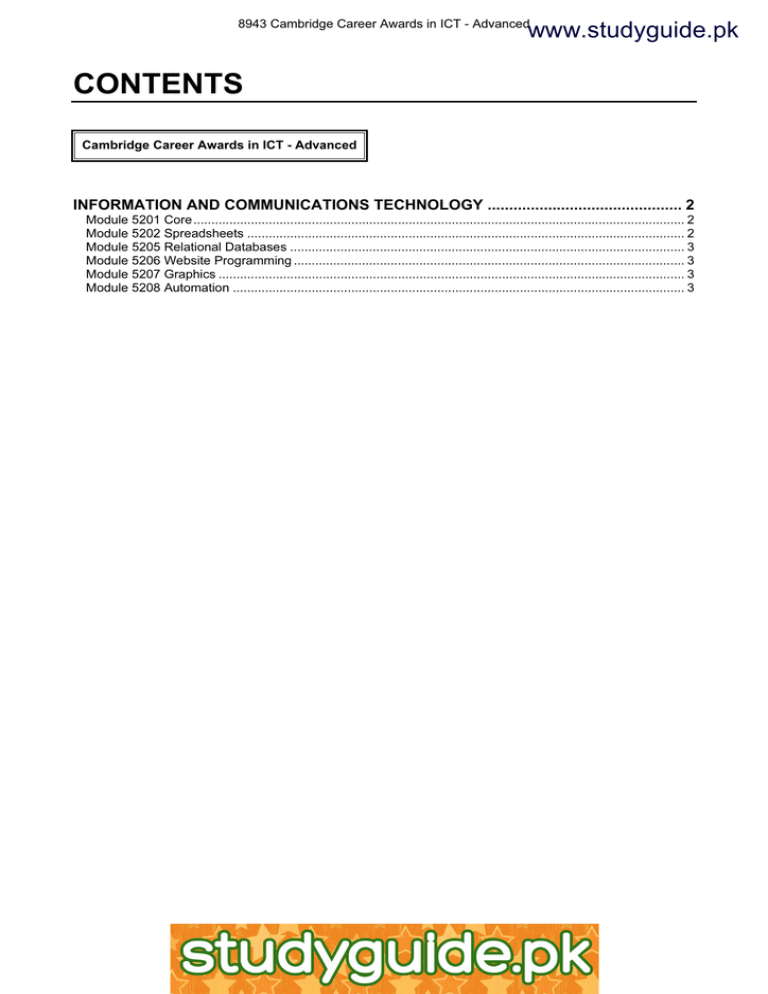
8943 Cambridge Career Awards in ICT - Advanced www.studyguide.pk CONTENTS Cambridge Career Awards in ICT - Advanced INFORMATION AND COMMUNICATIONS TECHNOLOGY ............................................. 2 Module 5201 Core ......................................................................................................................................... 2 Module 5202 Spreadsheets .......................................................................................................................... 2 Module 5205 Relational Databases .............................................................................................................. 3 Module 5206 Website Programming ............................................................................................................. 3 Module 5207 Graphics .................................................................................................................................. 3 Module 5208 Automation .............................................................................................................................. 3 http://www.xtremepapers.net 1 8943 Cambridge Career Awards in ICT - Advanced www.studyguide.pk INFORMATION AND COMMUNICATIONS TECHNOLOGY Overall general comments Again the scheme has gone from strength to strength, with entries rising considerably compared with the same period last year. The award is available in English, Spanish and Greek. The total number of entries in English showed a marked increase, especially at Standard Level and Advanced Level. The entries in Greek, which is only available at Standard Core, have also grown considerably. Spanish papers are also growing in popularity. This level comprises of a Core module and five Enhancement modules. There was an overall pass rate of 61% for these modules. Module 5201 Core There was an overall pass rate of 70% for this module, which can be compared with 59% in 2001 - 2002. The most frequent errors included: • The failure to submit all the required printouts, particularly the two different copies of the document, as required by the Question Paper. • The failure to understand the generic terms serif, and sans-serif. Many candidates tried to locate these as font styles rather than understanding that fonts such as Times New Roman contain short strokes or serifs on each letter, and that sans-serif fonts are without these. • Errors in page layout, with the failure to set margins or column widths as specified. • The failure to resize the imported graphic or to text wrap around this graphic. • Widows, orphans, numbered lists or tables split across a page were not removed by inserting page breaks. • Charts that were inserted but were unreadable, either because of the scaling of the chart or because of errors in the data series (usually because too much data had been selected as it was created). • Errors inserting new text into a numbered list and renumbering as specified in the Question Paper. • Errors in searching and sorting the database extract (particularly in maintaining the data integrity). Module 5202 Spreadsheets There was an overall pass rate of 57% for this module. The most common errors included: • The failure to manipulate strings within the spreadsheet. • The failure to correctly construct the pivot table or to construct it based upon the wrong data. • Candidates who calculated responses using external devices/software and entered values rather than formulae. • Candidates who could not produce formulae printouts of their work. • Column widths too narrow to enable either the value or all of the label/formulae to be viewed. • The failure to format cells as specified. 2 8943 Cambridge Career Awards in ICT - Advanced www.studyguide.pk Module 5205 Relational Databases There was an overall pass rate of 77% which compares to a 10% pass rate last year for this module. The most common errors included: • The failure to select the data using a wildcard. • The failure to produce grouped reports, or if produced they were grouped on the wrong fields. • The failure to sort database reports by the required fields. On some occasions the candidates confused ascending and descending order and on others got the sort priorities in the wrong order. • The failure to produce calculated fields and controls on an Access report. • Cross-tab queries (pivot tables) were not completed correctly, usually because the wrong source data was selected. Module 5206 Website Programming There were only nine entries for this module with a 78% pass rate. The errors included: • The failure to place radio buttons or a check box on the input form. • The failure to perform a length check on the data entered onto the form. • Calling all the objects the same name, with the same data source so that completion of more than one object erased the previously entered data. Module 5207 Graphics There was an overall pass rate of 57% for this module. The most significant error for the vast majority of candidates who did not reach the required standards was the failure to colour mask within a layer. The other significant reason for failure was the inability to print in colour. This module must be printed in colour to enable the Examiner to mark the script. Since such features as colour sampling, brightness, contrast, adjustment of primary colours within an RGB spectrum, hue, density, gradation and saturation are likely to be tested, the evidence of many of these changes can only be viewed in colour. Module 5208 Automation There was an overall pass rate of 35% for this module compared to 19% last year; however, there were relatively few entries. The most common errors included: • The failure to complete the Question Paper in the time allocated. • The inability to use or print an automated menu (either by printing out the VB, macros, hyperlinks or other methods of routing). • The lack of automation of the documents. 3 8943 Cambridge Career Awards in ICT - Advanced www.studyguide.pk • The inability to show evidence that the automation was present in the mail merged document (by printing out the document with the merge codes). • The failure to include and use merge commands like the SKIPIF and FILLIN functions at run time. • Confusion over the mathematical operators for greater than and less than. 4
